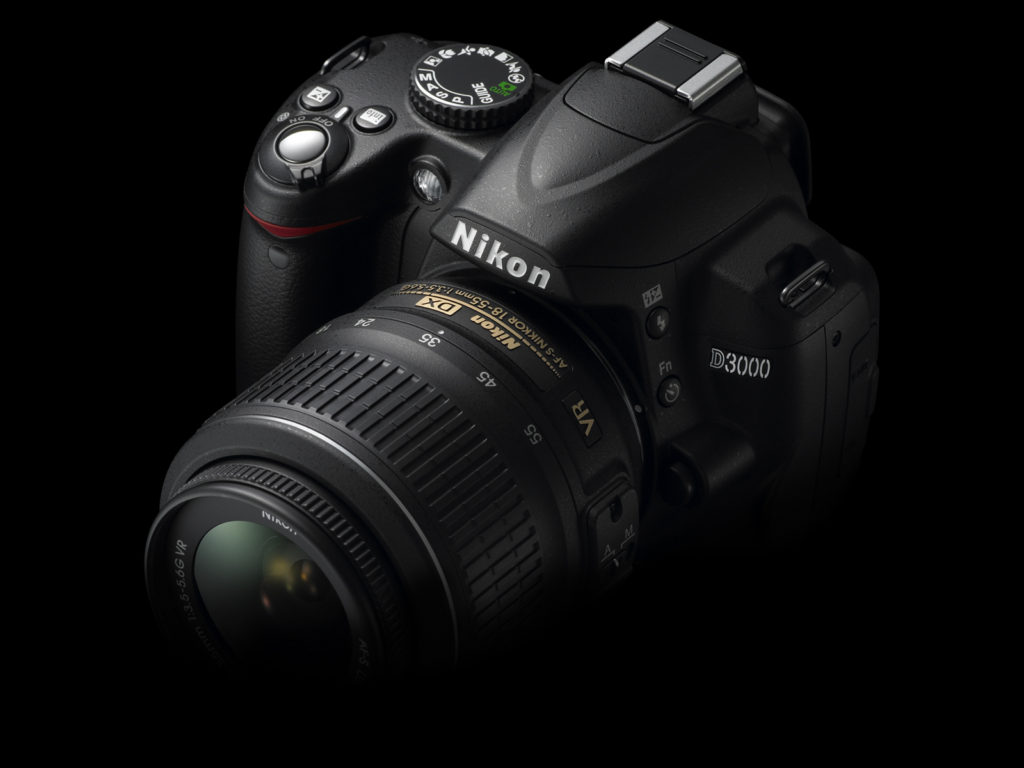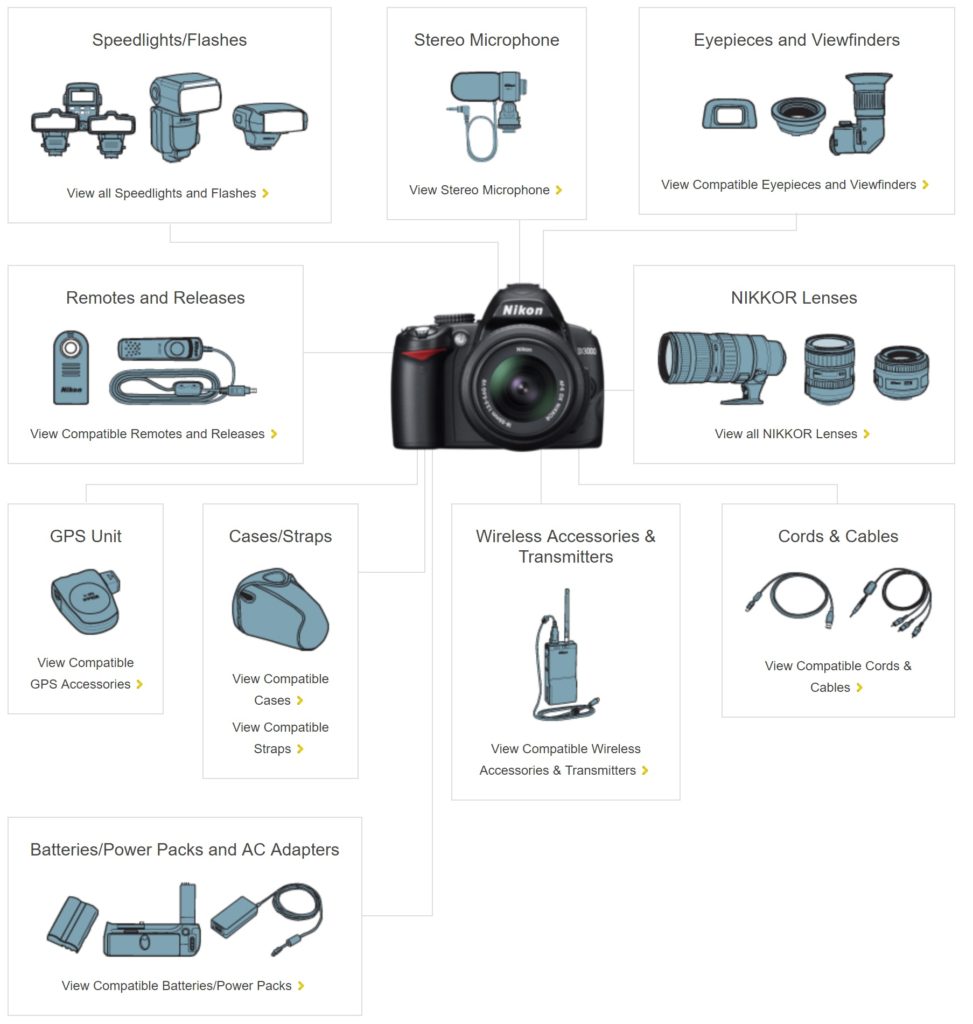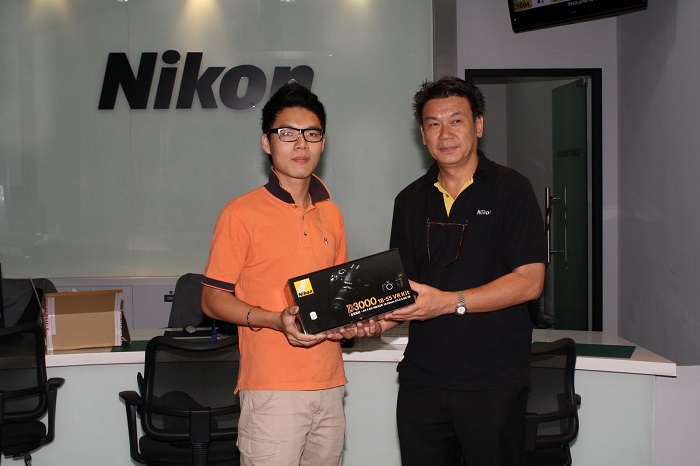Nikon 3000D Review.
The Nikon 3000D is an easy to use DX-format SLR that delivers superb images. Optimised for those who do not like to fuss with settings and those who may be new to DSLRs, the 3000D has a lot of user friendly features that will make sure you can get the best pictures with minimal fuss. The Guide Mode feature of the D3000 offers in-camera assistance by asking you about the image you want to capture and automatically optimize the camera settings accordingly. It can also be used to learn more about settings as the Guide Mode will offer information to help you go beyond it.

The D3000 also has a selection of scene modes which allow you to use pre-optimised settings for various shooting conditions. The Nikon D3000 comes with a 10.2 megapixels CCD image sensor, a highly accurate and responsive 11-point autofocus system and ISO sensitivity which ranges from 100 to 1600. You can also capture the spontaneous with the D3000’s burst mode which provides up to 3 frames per second continuous shooting speed. Whether composing your images, reviewing your shots or viewing the on screen guides, you can be sure that the 3-inch (230k dots) LCD on the Nikon D3000 will give you a clear and comfortable view.
The D3000 has a SD card memory slot and supports both SD and SDHC memory cards. Furthermore, the dual integrated dust reduction system will work to keep your sensor clean when you need to change the lens to avoid blemishes to your images.
So is a revamped AF system and new, even more user-friendly interface enough to make first-time DSLR buyers part with their cash? Or does the D3000 pale before live-view equipped competitors like the Canon EOS 1000D and Olympus E-450?
Nikon 3000D Key Features.
- 10.75 megapixel DX-format CCD sensor (effective pixels: 10.2 million)
- 3″ fixed LCD monitor (230,000 dots)
- Image sensor cleaning (sensor shake and ‘airflow’)
- 11 AF points (with 3D tracking)
- IS0 100-1600 range (100-3200 expanded)
- 3 frames per second continuous shooting (buffer: 6 raw, unlimited JPEG)
- Expeed image processing engine
- Extensive in-camera retouching including raw development and straightening
- 72 thumbnail and calendar view in playback
Nikon D3000 vs D5000: Key Differences.
The D3000 is pretty closely related to the D5000. There are important differences though, which are detailed here.
- 10 MP CCD sensor (D5000: 12.3 MP CMOS)
- Fixed LCD screen (D5000: Tilt/swivel screen)
- No Live View (D5000: Live View with contrast detect AF)
- No movie mode (D5000: Movie Mode with contrast detect AF)
- More limited ISO range (100-3200 as opposed to 200-6400)
- No control of Active D-Lighting intensity (D5000: choice of ‘low, normal, high’)
- No automatic lateral chromatic aberration correction (available in D5000)
- No choice of JPEG quality in RAW+JPEG shooting (JPEG basic available only)
- Slower continuous shooting (3fps compared to 4fps from the D5000)
- No exposure bracketing (available in D5000)
Accessories

The D3000 is a decent camera. Camera have only one complaint. That is the ISO capability, but the range is to be expected in the beginner range of cameras during the time it was made.
Nikon 3000D full specifications.
| Price (Body + 18-55mm VR Lens) | US: $449.00 UK: £379.99 EU: €440 |
|---|---|
| Body color | Black |
| Sensor | • 23.6 x 15.8 mm CCD sensor • Nikon DX format (1.5x FOV crop) • 10.2 million effective pixels • 10.75 million total pixels • RGB Color Filter Array • 12-bit A/D converter |
| Anti-dust measures | • Image sensor cleaning system • Airflow control system • Image dust off from reference frame (using optional Capture NX software) |
| Image sizes | • 3872 x 2592 (L) • 2896 x 1944 (M) • 1936 x 1296 (S) |
| Image quality | • NEF (12-bit compressed RAW) • JPEG fine (1:4) • JPEG normal (1:8) • JPEG basic (1:16) • NEF (RAW) + JPEG |
| Color space | • sRGB • Adobe RGB |
| Lens mount | Nikon F mount (with AF contacts) |
| Lens compatibility | • AF-S, AF-I • Other Type G or D AF Nikkor • Other AF Nikkor/AI-P Nikkor• Type D PC Nikkor• Non-CPU• IX Nikkor/AF Nikkor for F3AF • AI-P NIKKOR -All functions supported – All functions supported except autofocus – All functions supported except autofocus and 3D Color Matrix Metering II – All functions supported except some shooting modes – Can be used in mode M, but exposure meter does not function; electronic range finder can be used if maximum aperture is f/5.6 or faster – Cannot be used -All functions supported except 3D color matrix metering II |
| Autofocus | • 11 area TTL phase detection • Nikon Multi-CAM1000 autofocus module • Detection range: EV -1 to +19 (ISO 100 equivalent, at normal temperature) • Manual focus [M], Electronic range finding supported |
| Lens servo | • Single-servo AF (AF-S) • Continuous-servo AF (AF-C) • Automatic AF-S/AF-C (AF-A) • Manual focus (MF) |
| AF Area mode | • Single Area AF • Dynamic Area AF • Auto Area AF • 3D Tracking (11 points) • Closest Subject Priority Dynamic Area AF |
| Focus tracking | Predictive focus tracking automatically activated according to subject status in continuous-servo AF |
| Focus area | Can be selected from 11 focus points |
| Focus lock | Focus can be locked by pressing shutter-release button halfway (single-servo AF) or by pressing AE-L/AF-L button |
| AF Assist | White light lamp |
| Exposure mode | • Auto – Auto – Flash off • Scene Modes Portrait Landscape Child Sports Close up Night portrait • Programmed auto (P) with flexible program • Shutter-priority auto (S) • Aperture priority auto (A) • Manual (M) • GUIDE mode • Easy operation Auto No flash Distant subjects Close ups Sleeping faces Moving subjects Landscapes Portraits Night portrait • Advanced mode Soften backgrounds (aperture priority) Freeze motion (people) (shutter priority) Freeze motion (vehicles) (shutter priority) |
| Metering | TTL exposure metering using 420-pixel RGB sensor • Matrix :3D color matrix metering II (type G and D lenses); color matrix metering II (other CPU lenses) • Center-weighted: Weight of 75% given to a 8mm circle in center of frame • Spot: Meters 3.5 mm circle (about 2.5% of frame) centered on active focus area |
| Metering range | • EV 0 to 20 (3D color matrix or center-weighted metering) • EV 2 to 20 (spot metering) |
| Meter coupling | CPU coupling |
| Exposure comp. | • +/- 5.0 EV • 1/3 EV steps |
| AE Lock | Exposure locked at detected value with AE-L/AF-L button |
| AE Bracketing | None |
| Sensitivity | • Auto • ISO 100 • ISO 200 • ISO 400 • ISO 800 • ISO 1600 • ISO 3200 equiv. (Hi 1) |
| Auto ISO options | • On/Off • Maximum ISO (200, 400, 800, 1600 or Hi1) • Minimum shutter speed (1 to 1/2000 sec) |
| Shutter | • Electronically-controlled vertical-travel focal-plane shutter • 30 to 1/4000 sec (1/3 EV steps) • Flash X-Sync: up to 1/200 sec • Bulb • Time (requires optional Wireless Remote Control ML-L3) |
| White balance | Auto (TTL white-balance with 420 pixels RGB sensor) • Twelve manual modes with fine-tuning • Incandescent • Fluorescent Sodium-vapor lamps Warm-white fluorescent White fluorescent Cool-white fluorescent Day white fluorescent Daylight fluorescent Daylight fluorescent Mercury-vapor lamps • Direct sunlight • Flash • Cloudy • Shade • Preset white balance (immediate or from photo) |
| WB fine tuning | Yes, (except preset manual) |
| Image parameters | • Picture controls: Standard, Neutral, Vivid, Monochrome, Portrait, Landscape • Quick Adjust: 5 settings (adjusts Sharpening, Contrast and Saturation by preset amounts) • Sharpening: Auto, 10 levels • Contrast: Auto, 7 levels • Saturation: Auto, 7 levels • Hue: 7 levels |
| Viewfinder | • Optical fixed eye-level • Pentamirror type • Built-in dioptre adjustment (-1.7 to +0.5 m-1) • Eye point: 18 mm (at -1.0 m-1) • Frame coverage 95% (approx.) • Viewfinder magnification approx. 0.8x with 50mm lens at infinity; -1.0 m-1 • Focusing screen: Type B BriteView clear matte screen Mark V with superimposed focus brackets |
| LCD monitor | • 3.0″ TFT LCD • 230,000 pixel |
| Built-in flash | • Auto, Portrait, Child, Close-up, Night portrait • Auto flash with auto pop-up, • Manual pop-up in P, S, A or M modes • Guide number approx. 12/39 at ISO 100 (am/ft) • Guide number approx. 13/43 at ISO 100 (m/ft) in manual mode |
| Sync contact | X-contact only; flash synchronization at shutter speeds of up to 1/200 sec |
| Flash control | • TTL flash control by 420-segment RGB sensor. i-TTL balanced fill-flash for digital SLR and standard i-TTL fill-flash for digital SLR available when CPU lens is used with built-in flash, SB-400, SB-800, and SB-600 • Auto aperture with SB-800 and CPU lenses • Non-TTL auto with SB-800, 80DX, 28DX, 28, 27 and 22s • Range-priority manual with SB-800 |
| Flash mode | • Auto, Portrait, Child, Close-up: Auto, auto with red-eye reduction; fill-flash and red-eye reduction available with optional Speedlight • Night portrait: Auto, auto slow sync, auto slow sync with red-eye reduction; slow sync and slow sync with red-eye reduction available with optional Speedlight • Landscape, Sports: Fill-flash and red-eye reduction available with optional Speedlight • P, A modes: Fill flash, rear-curtain with slow sync, slow sync, slow sync with red-eye reduction, red-eye reduction • S, M modes: Fill flash, rear-curtain sync, red-eye reduction |
| Flash compensation | • -3 to +1 EV • 1/3 steps |
| Nikon Creative Lighting system | • Advanced Wireless Lighting supported with SB-900, SB-800 or SU-800 as commander • Flash Color Information Communication supported with built-in flash and all CLS-compatible flash units |
| Shooting modes | • Single frame shooting (S) mode • Continuous shooting (C) mode: approx. 3.0 frames per second • Self-timer • Quick-Response Remote • Delayed Remote |
| Continuous buffer | • JPEG: 100 frames in a burst but limited only by storage • RAW: Approx. ~ 6 frames (shooting continues at a slower rate) |
| Self-timer | • 2, 5, 10 or 20 sec |
| Remote control | • Remote Control ML-L3 (optional, Infrared) • Camera Control Pro software (optional) |
| Text input | Up to 36 characters of alphanumeric text input is available with LCD monitor and multi-selector; stored in EXIF header |
| Playback functions | • Full frame • Thumbnail (4, 9, or 72 images or calendar) • Playback with Playback zoom • Playback of stop-motion movies created with D3000 • Slide Show • Histogram Display • Highlights • Auto Image Rotation • Image Comment (up to 36 characters) |
| Orientation sensor | Yes (Rotates user interface when using camera in portrait orientation) |
| Storage | • Secure Digital / Secure Digital HC • FAT / FAT32 • Supports firmware update via SD card |
| Video output | NTSC or PAL selectable |
| Connectivity | • USB 2.0 (Hi-Speed) • Mass storage / PTP selectable • Video out • DC-IN (optional AC adapter and adapter connector) |
| Languages | Chinese (Simplified and Traditional), Danish, Dutch, English, Finnish, French, German, Italian, Japanese, Korean, Norwegian, Polish, Portuguese, Russian, Spanish, Swedish |
| Power | Lithium-Ion battery pack EN-EL9a (7.2 V, 1080 mAh) |
| Working environment | • 0 to 40°C (32 to 104°F) • Less than 85% humidity |
| Dimensions | 126 x 97 x 64 mm (5.0 x 3.8 x 2.5 in) |
| Weight (no batt) | 485g (1.1 lb) |
| Weight (inc. batt) | 536 g (1.2 lb) |
| Supplied accessories | • Rechargeable Li-ion Battery EN-EL9a • Quick Charger MH-23 • Eyepiece Cap DK-5 • Rubber Eyecup DK-20 • USB Cable UC-E4 • Video Cable EG-D100 • Camera Strap AN-DC3 • Accessory Shoe Cover BS-1 • Body Cap BF-1A, Software Suite CD-ROM |
| Optional accessories | Wireless Remote Control ML-L3, Capture NX2, Camera Control Pro, AC Adapter Connector EP-5, AC Adapter EH-5, Video Cable EG-D100, Semi Soft-Case CF-DC1, Speedlight SB-900/600/400/T041/R1C1 |
Nikon D3000 Body and Design
